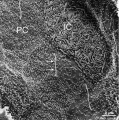File:Rat kidney HIM 04.jpg: Difference between revisions
(==Adult Rat Kidney Collecting Duct Principal Cell HIM== Each principal cell has one long, solitary cilium and numerous short, stubby microvilli. Collecting duct principal cells mediate the collecting duct's influence on sodium and potassium balance thr...) |
|||
| (One intermediate revision by the same user not shown) | |||
| Line 1: | Line 1: | ||
==Adult Rat Kidney Collecting Duct Principal Cell HIM== | ==Adult Rat Kidney Collecting Duct Principal Cell and Intercalated Cell HIM== | ||
* '''PC''' - Principal cell has one long, solitary cilium and numerous short, stubby microvilli. | |||
* '''IC''' - Intercalated cell has numerous elaborate apical microplicae, ridge-like folds of the plasmalemma, and no cilium. | |||
Bar = 2 µm. | |||
Collecting duct principal cells mediate the collecting duct's influence on sodium and potassium balance through sodium and potassium channels located on the cell's apical membrane. Intercalated cells come in α and β forms and have a role in acid-base homeostasis. | |||
A new technique called Helium Ion Microscopy (HIM) gives similar high resolution 3D images, using a scanning beam of He<sup>+</sup> ions, and fixed tissue without the coating required for SEM. | A new technique called Helium Ion Microscopy (HIM) gives similar high resolution 3D images, using a scanning beam of He<sup>+</sup> ions, and fixed tissue without the coating required for SEM. | ||
{{Rat kidney HIM links}} | {{Rat kidney HIM links}} | ||
Latest revision as of 15:12, 14 May 2014
Adult Rat Kidney Collecting Duct Principal Cell and Intercalated Cell HIM
- PC - Principal cell has one long, solitary cilium and numerous short, stubby microvilli.
- IC - Intercalated cell has numerous elaborate apical microplicae, ridge-like folds of the plasmalemma, and no cilium.
Bar = 2 µm.
Collecting duct principal cells mediate the collecting duct's influence on sodium and potassium balance through sodium and potassium channels located on the cell's apical membrane. Intercalated cells come in α and β forms and have a role in acid-base homeostasis.
A new technique called Helium Ion Microscopy (HIM) gives similar high resolution 3D images, using a scanning beam of He+ ions, and fixed tissue without the coating required for SEM.
- HIM Image Links: Kidney Glomerulus | Collecting Tubule - Principal and Intercalated Cell | Principal Cell - cilium and microvilli | Principal Cell - cilium and microvilli | Renal System Development | Rat Development | Scanning Electron Microscopy
Reference
<pubmed>23505418</pubmed>| PMC3591388 | PLoS One.
Copyright
© 2013 Rice et al. This is an open-access article distributed under the terms of the Creative Commons Attribution License, which permits unrestricted use, distribution, and reproduction in any medium, provided the original author and source are credited.
Journal.pone.0057051.g006 Original figure 6 Panel A cropped from full image, adjusted in size, contrast and labelling. Journal.pone.0057051.g006a.jpg
File history
Yi efo/eka'e gwa ebo wo le nyangagi wuncin ye kamina wunga tinya nan
| Gwalagizhi | Nyangagi | Dimensions | User | Comment | |
|---|---|---|---|---|---|
| current | 15:05, 14 May 2014 |  | 599 × 602 (142 KB) | Z8600021 (talk | contribs) | ==Adult Rat Kidney Collecting Duct Principal Cell HIM== Each principal cell has one long, solitary cilium and numerous short, stubby microvilli. Collecting duct principal cells mediate the collecting duct's influence on sodium and potassium balance thr... |
You cannot overwrite this file.
File usage
The following page uses this file: